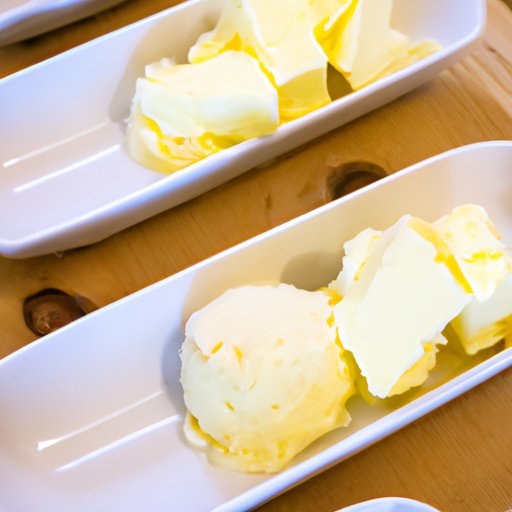
Introduction
Butter is a staple in many households, and yet, few people know how to make it from scratch. Buying store-bought butter can be convenient, but making your own butter is not only fun and rewarding but also allows you to customize the flavor and nutritional content to your liking. In this article, we provide a comprehensive guide on how to make butter from scratch, along with tips on adding different flavors and making it healthier for you and the environment.
Step-by-Step Guide
Butter-making is a relatively simple process that involves separating cream from milk. The cream is then shaken or churned until the fat particles come together to form butter.
Here’s what you will need:
- Heavy cream (preferably organic)
- Sea salt (optional)
- Food processor or jar with a tight-fitting lid
- Cheesecloth or butter muslin (optional)
Step 1: Pour the heavy cream into your food processor or jar. If you are using a jar, fill it halfway to allow room for the cream to churn.
Step 2: Secure the lid tightly and start shaking or blending the cream. If you are using a food processor, use the low speed setting to prevent the cream from splattering.
Step 3: After a few minutes of shaking or blending, the cream will start to thicken and turn into whipped cream. Keep going until it starts to break apart, and you can see the yellow butterfat separating from the white buttermilk.
Step 4: Once you see the butterfat separating, stop churning or shaking and pour the mixture into a strainer lined with cheesecloth or butter muslin over a bowl to catch the buttermilk.
Step 5: Use clean hands or a wooden spoon to press the butter against the cheesecloth, squeezing out any remaining buttermilk. The buttermilk can be saved for baking or cooking.
Step 6: Rinse the butter under cold running water to remove any leftover buttermilk.
Step 7: Add sea salt to taste and knead the butter using a wooden spoon or your hands until all the salt is incorporated.
Step 8: Wrap the butter in parchment paper or store it in an airtight container in the refrigerator.
Tip: You can make larger batches of butter by using a stand mixer or traditional butter churn. Remember that one quart of cream produces about one pound of butter.
Historical Perspective
Butter has been a part of human cuisine for thousands of years. In ancient times, people would collect milk by hand and let it sit, allowing the cream to separate from the milk, which was then used to produce butter.
As agriculture developed, butter-making evolved into a more sophisticated process with the use of churns, which expedited the separation of cream from milk. Butter production became a widespread industry in Europe during the Middle Ages, particularly in regions with high milk production such as Scandinavia and Switzerland.
Today, butter is still an essential part of many cuisines worldwide, with regional variations and special production methods. For example, French butter, known as Beurre de Baratte, is made using traditional churns and has a distinct nutty flavor compared to American butter.
Flavor Variations
Homemade butter can be made more exciting with different flavors and ingredients. Here are some flavor variations you can try:
- Herb Butter: Add minced herbs such as rosemary, thyme, or sage to your butter before kneading it together
- Spiced Butter: Mix in spices such as cinnamon, ginger, or nutmeg for a sweet butter or cumin, chili powder, or paprika for a savory spread
- Citrus Butter: Add lemon, orange, or lime zest to your butter for a tangy flavor, or mix in fresh juice for a subtle citrus taste
- Honey Butter: Drizzle honey into your butter for a sweet spread that pairs perfectly with biscuits or toast
To make flavored butter, add the desired ingredient to the cream before churning or knead it into the butter itself. Experiment with different flavor combinations to find your favorite blend!
Health Benefits
Making your own butter allows you to control the nutritional content of your spread. Homemade butter is often higher in beneficial nutrients such as vitamins A and D and healthy fats like butyric acid. Using organic cream with no preservatives or additives ensures that your butter is free of harmful chemicals and hormones.
For an even healthier butter, you can adjust the fat content. Commercial butter is typically made with about 80% fat, but you can lower the fat content by using low-fat or whole milk instead of cream. Alternatively, you can opt for grass-fed cream, which has a higher nutrient profile and may be better for the environment.
Sustainable Options
Butter-making can also be a sustainable practice. Using organic cream and grass-fed dairy promotes animal welfare and supports sustainable agriculture practices. You can also reduce waste by using leftover buttermilk for baking or cooking.
You can take things a step further by sourcing your equipment and ingredients locally. Look for butter churns or hand-held whisks and bowls at flea markets or antique stores and find a local dairy farm that sells organic cream or milk.
Conclusion
Making butter is a straightforward process that can be customized to suit your taste and nutritional preferences. Experiment with different flavors and techniques and discover the joy of homemade butter. By building a connection with your food, you can also promote sustainable practices and support local agriculture.




